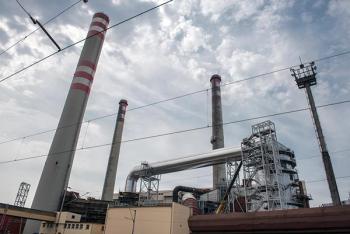
|Articles|April 9, 2021
Energy outlook rundown
Author(s)TMI Staff & Contributors
Advertisement
Natural Gas
- In March, the U.S. benchmark Henry Hub natural gas spot price averaged $2.62 per million British thermal units (MMBtu), which is down from the February average of $5.35/MMBtu. The Henry Hub price declined primarily because the cold weather and related high demand and market disruptions that drove prices to recent highs in February abated in March. The US Energy Information Administration (EIA) expects Henry Hub spot prices will average $2.73/MMBtu in the second quarter of 2021 and will average $3.04/MMBtu for all of 2021, which is up from the 2020 average of $2.03/MMBtu. The EIA expects that continued growth in liquefied natural gas (LNG) exports, with only a slight corresponding increase in dry natural gas production, will contribute to the average Henry Hub spot price rising to $3.11/MMBtu in 2022.
- EIA expects that U.S. consumption of natural gas will average 82.9 billion cubic feet per day (Bcf/d) in 2021, down 0.4% from 2020. The decline in U.S. natural gas consumption is a result of less natural gas consumed for electric power generation because of higher natural gas prices compared with last year. In 2021, the EIA expects residential and commercial natural gas consumption will rise by a total of 1.1 Bcf/d from 2020 and industrial consumption will rise by 1.4 Bcf/d from 2020. Rising consumption outside of the power sector results from expanding economic activity and colder temperatures in 2021 compared with 2020. The EIA expects U.S. natural gas consumption will average 82.1 Bcf/d in 2022.
- EIA estimates that natural gas inventories ended March 2021 at nearly 1.8 Tcf, which is 2% lower than the five-year (2016–20) average. The winter of 2020–21 had more natural gas withdrawn from storage than the five-year average largely as a result of the cold February temperatures that occurred amid low natural gas production. The EIA expects that rising natural gas production and lower natural gas consumption for power generation than in the past two summers will contribute to storage injections outpacing the five-year average in 2021. The EIA forecasts that natural gas inventories will end the 2021 injection season (end of October) at more than 3.7 Tcf, which is equal to the five-year average.
- EIA forecasts that U.S. production of dry natural gas will average 91.4 Bcf/d in 2021, which is about the same as the 2020 average. In our forecast, dry natural gas production falls to a low point of 90.8 Bcf/d in May 2021 before steadily increasing through most of the remainder of 2021, reaching a high of 92.4 Bcf/d in November 2021. The increase in production in 2021 reflects higher forecast natural gas prices as well as higher forecast crude oil prices, which is expected to contribute to more associated natural gas production, especially in the Permian region.
Electricity, coal, renewables, and emissions
- EIA forecasts that electricity consumption in the United States will increase by 2.1% in 2021 after falling 3.8% in 2020. Electricity sales to the industrial sector are forecast to grow by 4.2% in 2021. Retail electricity sales to the residential sector is forecast to grow by 2.3% in 2021. This increase is primarily a result of colder temperatures in the first quarter of 2021 compared with the same period in 2020. Retail sales of electricity to the commercial sector is forecast to increase by 0.7% in 2021. Much of the increased electricity consumption across the sectors reflects improving economic conditions in 2021. For 2022, U.S. electricity consumption will grow by another 1.3%.
- EIA expects that the share of electric power generated with natural gas in the United States will average 36% in 2021 and 35% in 2022, down from 39% in 2020. The forecast share for natural gas declines in response to a 39% increase in the price of natural gas delivered to electricity generators from an average of $2.39/MMBtu in 2020 to $3.31/MMBtu in 2021. The higher expected natural gas prices cause the forecast share of generation from coal to rise from 20% in 2020 to 22% this year, and to 23% next year. New additions of solar and wind generating capacity contribute to our forecast that the share of U.S. generation from renewable energy sources will rise from 20% in 2020 to 21% in 2021 and to 22% in 2022. The nuclear share of U.S. generation declines from 21% in 2020 to 20% in 2021 and to 19% in 2022, reflecting the retirement of capacity at some nuclear power plants.
- EIA forecasts that planned additions to generating capacity from wind and solar energy in 2021 and 2022 will contribute to increasing electricity generation from those sources. The U.S. electric power sector added 14.5 gigawatts (GW) of new wind capacity in 2020. The EIA expects 16.1 GW of new capacity will be added in 2021 and 5.8 GW in 2022. U.S. utility-scale solar capacity rose by an estimated 10.4 GW in 2020. Our forecast for added utility-scale solar capacity is 15.8 GW in 2021 and 14.9 GW in 2022. In addition, about 5 GW of small-scale solar (projects with less than 1 megawatt of capacity) are added annually over the 2021–22 STEO forecast.
- EIA expects U.S. coal production to total 585 MMst in 2021, 46 MMst (9%) more than in 2020. In 2022, coal production will grow by an additional 16 MMst (3%). Coal used to generate electric power will increase by 13% to 495 MMst in 2021 and by 4% to 514 MMst in 2022. The increase in coal production in 2021 will be the largest on a percentage basis in the Interior region, owing to increased domestic electricity generation. In 2022, EIA expects it will be largest in the Appalachia region, partly as a result of metallurgical coal exports rising to 54 MMst next year, up 27% from 2020 levels.
- EIA estimates that U.S. energy-related carbon dioxide (CO2) emissions decreased by 11% in 2020. This decline in emissions was the result of less energy consumption related to the economic contraction resulting from the COVID-19 pandemic. In 2021, the EIA forecasts energy-related CO2 emissions will increase by about 5% from the 2020 level as economic activity increases and leads to rising energy use. Energy-related CO2 emissions is expected to rise in 2022, but by a slower rate of 2%. After declining by 19% in 2020, coal-related CO2 emissions will rise by 13% in 2021 and by 4% in 2022.
Global liquid fuels
- The April Short-Term Energy Outlook (STEO) remains subject to heightened levels of uncertainty because responses to COVID-19 continue to evolve. Reduced economic activity related to the COVID-19 pandemic has caused changes in energy demand and supply during the past year and will continue to affect these patterns in the future. U.S. gross domestic product (GDP) declined by 3.5% in 2020 from 2019 levels. This STEO assumes U.S. GDP will grow by 5.6% in 2021 and by 4.2% in 2022. The U.S. macroeconomic assumptions in this outlook are based on forecasts by IHS Markit.
- For the 2021 summer driving season (April–September), the U.S. Energy Information Administration (EIA) forecasts U.S. regular gasoline retail prices will average $2.78 per gallon (gal), up from an average of $2.07/gal last summer (Summer Fuels Outlook). Higher forecast gasoline prices reflect higher forecast crude oil prices, higher wholesale gasoline refining margins, and higher U.S. consumption of motor gasoline. For all of 2021, the EIA expects U.S. retail prices of regular-grade gasoline to average $2.66/gal and retail prices for all grades to average $2.78/gal, which would result in the average U.S. household spending about $480 (31%) more on motor fuel in 2021 compared with 2020.
- EIA expects U.S. gasoline consumption to rise in response to growing levels of GDP and employment. In addition, as COVID-19 vaccines are more widely distributed, driving will increase, causing gasoline consumption to rise. The EIA forecast that U.S. gasoline consumption in 2021 will average 8.6 million barrels per day (b/d), which is up from consumption in 2020 of 8.0 million b/d but down from consumption in 2019 of 9.3 million b/d.
- Brent crude oil spot prices averaged $65 per barrel (b) in March, up $3/b from February and up $33/b from March 2020, the onset of the COVID-19 pandemic in the United States. Rising Brent prices in March continued to reflect expectations of rising oil demand as both COVID-19 vaccination rates and global economic activity have increased, combined with ongoing crude oil production limits from members of the Organization of the Petroleum Exporting Countries (OPEC) and partner countries (OPEC+). EIA forecasts that Brent prices will average $65/b in the second quarter of 2021, $61/b during the second half of 2021, and $60/b in 2022.
- EIA expects global oil inventories to fall by 1.8 million b/d in the first half of 2021. Forecast increases in global oil supply will contribute to a mostly balanced market during the second half of 2021. However, the forecast depends heavily on future production decisions by OPEC+, the responsiveness of U.S. tight oil production to oil prices, and the pace of oil demand growth, among other factors.
- EIA expects OPEC crude oil production will rise from an average of 25.1 million b/d in the first quarter of 2021 to 25.8 million b/d in the second quarter. The increase is the result of the April 1 OPEC+ announcement to begin raising production targets in May. It also reflects Saudi Arabia unwinding voluntary cuts of 1.0 million b/d between May and July. OPEC crude oil production is expected to rise to almost 27.9 million b/d in the second half of 2021.
- EIA estimates that the world consumed 96.0 million b/d of petroleum and liquid fuels in March, an increase of 4.7 million b/d from March 2020. Global consumption of petroleum and liquid fuels is forecast to average 97.7 million b/d for all of 2021, which is up by 5.5 million b/d from 2020. Consumption will increase by 3.7 million b/d in 2022 to average 101.3 million b/d. The EIA revised growth in global liquid fuels consumption in 2021 higher from last STEO. The higher forecast is primarily a result of higher global GDP growth forecasts from Oxford Economics, which increased 0.4 percentage points from the March STEO to 6.2% for 2021.
- According to EIA’s most recent data, U.S. domestic crude oil production averaged 11.1 million b/d in January 2021. The EIA estimates that U.S. domestic crude oil production declined by 0.8 million b/d in February, mostly because of cold temperatures that affected much of the country, particularly Texas. Crude oil production is expected to average 10.9 million b/d in the second quarter of 2021 and increase to almost 11.4 million b/d by the fourth quarter of 2021. U.S. crude oil production will average 11.9 million b/d in 2022. The forecast of rising U.S. crude oil production is the result of our expectation that West Texas Intermediate crude oil prices will remain above $55/b through the forecast period.
Newsletter
Power your knowledge with the latest in turbine technology, engineering advances, and energy solutions—subscribe to Turbomachinery International today.
Advertisement
Advertisement
Advertisement





